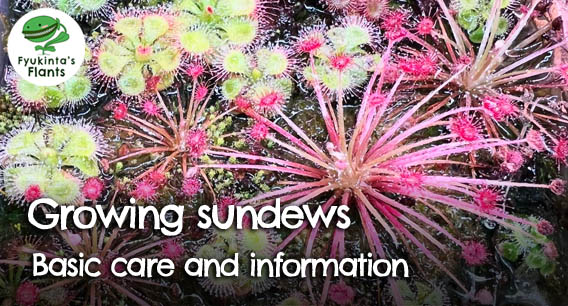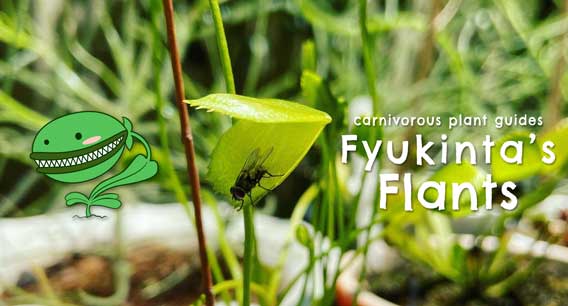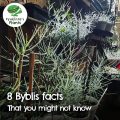ㅤㅤㅤ
Propagating sundews is fairly easy through seeds, leaf cuttings, or root cuttings, depending on the sundew. This guide will cover how to propagate certain sundews based on my experience and some experiences from my customers.
 This propagation guide covers the following:
This propagation guide covers the following:
• Propagating sundews from seeds
ㅤㅤ• Using a seed kit
ㅤㅤ• Harvesting and storing sundew seeds
ㅤㅤ• Seed germination
ㅤㅤ• Storing sundew seeds
• Propagating sundews from leaf cuttings and pullings
• Propagating sundews from root cuttings
• Propagating sundews through division
• Are you ready to grow sundews?
Propagating sundews from seeds
Growing sundews from seed is slow, like with most carnivorous plant seeds, but it’s still a rewarding experience. Depending on the kind of sundew, seeds can germinate between one and six weeks, depending on the viability of the seeds and the general growing conditions.

Sundews grown from seed
Using a seed kit
If you purchased a seed kit, just follow these steps to start growing your sundews:

- Fill your pot with the growing media. Make sure to pack the pot tightly.
- Water the top of the pot a little bit at a time with distilled or rainwater.
- Sow your seeds on top of the media.
- Put the pot in a clean plastic tub/tray with distilled or rainwater.
- Position the pot where it can receive strong, steady light. You can also put the pot under a grow light, but make sure the grow light is strong enough. I use 18-watt LED lights, and my plants are only 6 inches away from the light.
If you have your own sundew seeds you’d like to sow, the rest of this guide will help you out.
Harvesting and storing sundew seeds
There are certain sundews that are self-pollinating. This means their flowers, which grow in tall stalks above the plant, will produce seeds by themselves. Propagating sundews for these varieties is fairly easy because of this.
A fun fact is that sundews evolve to grow tall flower stalks because this way, pollinators won’t get caught in the sundew’s sticky and dewy leaves.

A sundew flower stalk
These are the sundews that I know are self-pollinating, some of which are available on my online shop:
- Burmanii
- Burmanii Humpty Doo
- Capillaris
- Intermedia
- Spatulata
- Tokaiensis
Of course, you can also try hand-pollinating sundews by collecting pollen and brushing it onto the flowers of another sundew. This is one way hybrids are manually made. However, this isn’t something I’ve tried yet, so I can’t offer advice on it.
Seed germination
This guide will help you germinate seeds in general, whether you get seeds from me or your own garden! First, prepare your washed/low ppm growing media in pots or a clean plastic tub, and make sure that it’s moist with low ppm water (distilled, rain, RO, or aircon drip water). You can measure the ppm of any water using a TDS meter.
Also, make sure that the pot is packed tightly, especially at the bottom. This will make sure the top layer where the seeds won’t dry out completely.

D. Burmannii seedlings!
Sprinkle your sundew seeds over the surface of the media. You can do this by pressing your index finger over the seeds and rubbing your thumb against it over the media to make the seeds fall. Try to spread the seeds out, and do NOT do this in front of an electric fan or when it’s windy. Sundew seeds are extremely small, almost like dust. Try your best not to make them clump up.
As mentioned by Growsundews.com, do NOT bury the seeds, or they will NOT grow.
Storing sundew seeds
If you want to store sundew seeds, whether to sow later, trade with, or sell to other carnivorous plant hobbyists, you can try this tapeless seed packing method.

Mixed sundew seeds from dried flower stalks and packed in paper
ㅤㅤㅤㅤ
All you need is a piece of paper and a bit of folding. I learned this from growsundews.com years ago, and it’s still my favorite way of packing seeds. I have a step-by-step video on how to do this below.
Propagating sundews from leaf cuttings and pullings
Seeds aren’t the only method for propagating sundews! These fantastic plants can also be propagated through their leaves or pullings. This is a great way to grow sundew cultivars that don’t produce seeds on their own. They’ll thrive in a similar environment as seeds, needing a lot of light to germinate.

D. Adelae plantlets grown from leaf cuttings
These varieties can easily be grown by just cutting a leaf off from a plant, and laying it on wet media.
- Adelae
- Binata
- Eloisiana
- Filiformis
- Rotundifolia
- Tracyi

D. Filiformis leaf cuttings
Pullings are a little harder to get if you’re unfamiliar, but this is the easiest way to propagate petiolaris complex sundews. These are the varieties that look like fireworks. Simply pull off their leaves with some of the stem or middle part intact and lay that across wet media.
- Paradoxa
- Petiolaris complex
For both leaf cuttings and pullings, make sure that the media you use is wet or always moist. I personally prefer keeping them wet to ensure they don’t dry out. If your cuttings dry out completely, they won’t strike or make little plantlets.
Propagating sundews from root cuttings
There are also some sundews with thick roots capable of producing plants! You can do these with sundews like D. Adelae and D. Binata since both these sundews have huge roots. It’s good to trim a root or two during a repotting and lay them on wet media (same as with cuttings and pullings).

Little D. Binata sundews growing from root cuttings
However, you’ll also notice that these plants will end up growing new plants from their roots anyway if you pot them in transparent pots, or in a shallow pot where the roots are forced to grow sideways.
Propagating sundews through division
Yet another way to propagate sundews is by dividing their natural divisions. Some sundews will naturally propagate themselves by creating offshoots, developing clumps. You can separate these clumps and repot them to have more sundews!

D. Eloisiana can be easily propagated through divisions or leaf pullings
This tends to happen the most to D. Petiolaris Complex, D. Falconeri x Ordensis, and D. Eloisiana in my collection. When that happens, I wait for the division to grow to a size close to the main plant before I separate them.

D. Falconeri x Ordensis dividing
(smaller leaves are visibly poking between the bigger leaves)
Are you ready to grow sundews?
If you have any questions, feel free to ask in a comment! For more information about sundews, you can check my hsundew care guide.
You can also message me on Facebook or Instagram. I post plant content every day about learnings, experiments, and just the regular progress of the plants in my collection.
Check out my other carnivorous plant guides
If you haven’t seen them yet, I have guides on how to prepare for your first carnivorous plant and how to grow other carnivorous plants like Venus flytraps and Byblis in the Philippines. You can check here for all my guides.
Carnivorous plant shop
You can also check what carnivorous plants and gardening items I have for sale in the links below!
I sell Venus flytraps, sundews, pitcher plants, and more carnivorous plants in my online shop, all grown in my own little garden in Marikina. I also have pots, Maxsea fertilizer, and even some non-carnivorous plants available. For grow lights, shelves, and even water trays I use, you can check my Shopee affiliate link collection.
I ship nationwide, and customers can enjoy free shipping and a loyalty card.










